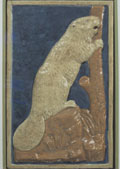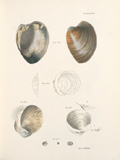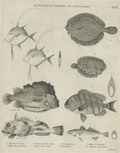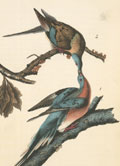|
In 1609, when Henrik Hudson
sailed the Half Moon into New York Harbor and up the
river that would be named for him, he was seeking a new route
to China. Although this proved a fruitless quest, he reported
enthusiastically to his sponsor, the Dutch East India Company,
about a verdant land rich in animal life, with excellent agricultural,
lumbering, and fur-trading potential. The subsidiary Dutch
West India Company, created to handle New World matters, funded
additional expeditions, sending colonists and merchants to
exploit the natural riches of the new land. In 1624, the city
of New Amsterdam was founded on the southern end of Manhattan
island, brought into being primarily to make money for shareholders
of the Dutch company.
Beavers played a preeminent
role in the early economic history of New York City, with
trade in the valuable pelts bringing wealth to many. Fur trading
continued well into the 19th century, even after the local
beaver population was depleted, and the city continues today
to be the home of the fur industry. The city’s official seals
have always included an image of beavers, beginning with the
1623 Dutch seal of the Colony of New Netherland, encompassing
land between the Delaware and Connecticut rivers.
The city’s fish and shellfish
industries were also of great economic importance. The abundant
oysters and clams were devoured in great quantities locally,
and exported across the country. But heedless overfishing,
and increasing water pollution, led to the end of most legal
shellfishing early in the 20th century, when oysters from
New York Harbor caused an outbreak of typhoid in 1916.
The delicious Quahog or
Hard-shelled Clam played a vital role in the economy of the
Lenape Indians. The clamshells were an important source of
the beads known as wampum, used as money not only by
the natives, but also by early Dutch colonists.
Although some of the local
native animals abundant in the 17th century, such
as the Eastern Gray Squirrel, have continued to thrive, others,
such as the Black Bear, retreated elsewhere as the local forests
disappeared. And other species, such as Passenger Pigeons,
once the most numerous birds in the world, are now extinct.
Check
out the sighting
log to record your interaction with some of the native
New York City wildlife featured in Urban Neighbors.
You may also browse the sighting log by animal, borough, park
or natural area, and/or habitat to view a sighting you have
submitted or to read others’ observations.
|
1

Beaver /
Collection of the Metropolitan Transportation Authority Arts
for Transit
2

Northern Quahog /
NYPL
3

Fishes / NYPL
4

Passenger Pigeon /
NYPL
5

Black Bear / NYPL
|






